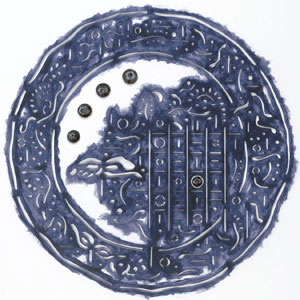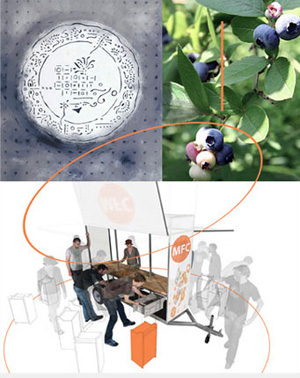


Eye Eat Too
In the 1950's, the art theorist Harold Rosenberg famously said that the apples that appeared in old still-lifes "had to be brushed off the table … so that nothing would get in the way of the act of painting." Eye Eat Too refutes that dichotomy between food and painting. Deborah Doering brings the food into the art so that we can visually eat well, while still preserving dynamic artistic action in her fluid core forms.
Eye Eat Too unites two established themes in Doering's artistic work: her symbolic system of form based on a rotated disk, and the culture of food and nourishment.
The symbolic system begins with a disk or ring. Imagine a disk (perhaps a donut, or a bagel, or a bit of the circular breakfast cereal) hanging in space. From one perspective, we see it as a round tube, which flattened onto the surface of the painting is just O, evoking the number zero. But if we rotate it and eye it edge-on, it looks like a line, which flattened onto the surface is just │, evoking the number one. From these forms, Doering has built a distinctive calligraphy, which inscribed on paper or canvas becomes compositions in some foreign, but decipherable language. In her most recent work, Doering extends that zero-one symbol system to include short curves, with branches, which evoke growing plants or animal tracks. This naturalistic extension of the zero-one code points the viewer to Doering's second theme: food and eating, as both nourishment and social interaction.
The title Eye Eat Too translates a German saying "Das Auge isst mit" that expresses the importance of food presentation for fine dining. (In 2011, Doering was artist-in-residence in Berlin and Kassel Germany.) In her food-theme work, painted circles become table plates and dining tables. She evokes the etymological connections from disk to dish in English and to tisch (table) in German. In Eye Eat Too, we also see a repeated circular form (about 9" diameter) with a pattern of wavy lines around the edge. This form is a subtle reference to Doering's family dinner plates, which we recognize as a familiar pattern in table ware.
The installation cannot be viewed on a purely visual level, separated from the experience of food. Doering is artist as food activist. In Eye Eat Too, she draws on the blueberry, which she conceives as a small but important food, high in antioxidants, easily preserved by freezing, and of course fun to eat. Experiencing the installation, we confront living blueberry plants, nurtured with growth lights in the zero-one code, held in a grid delimited by the branching variations on her plate designs.
Food comes to the canvas through a painted rendition of a crudely pixilated photograph of a meal. And the blueberry blue of the drawings that surround the room draws the mind to the edible berry. This theme will be echoed when blueberries are used in a
Sept. 18 collaborative art event with the Mobile Food Collective (a project of Chicago's prestigious Archeworks) in support of Eye Eat Too. The installation is not to be experienced on a purely visual level, separated from nourishment.
The process behind the works in Eye Eat Too is significant. The blue works on Yupo are based on stencils also cut from Yupo. The crude transference of blueberry ink through the mylar-like Yupo stencil onto the material's surface leaves an image that shows the
flow of the ink and hand of the artist. The stencils are then supplemented with direct applications of the blueberry ink. These works are unique works, not prints, but works making use of a stencil process. Shifting, sliding stencils make possible the combination
of calligraphic code and dynamic movement essential to this art. This dynamism within calligraphy is further emphasized in those works where we see dots indicating the remnant of a grid defining the lines of a written page. The grid of dots is partly blurred
or destroyed with expressive strokes in blueberry-toned ink. Again we see that mix of motion and stasis in the process of transferring a pixilated photograph by hand to the canvas in the larger works on canvas.
A note on the collaborative art event "Blue Plate Special" : the Mobile Food Cooperative is a project of Archeworks. Showcased at the US pavilion at the Venice Biennale in 2010, it now gives presentations on progressive food culture from its mobile units. The MFC in collaboration with Doering's DOEprojekts has kindly created the event "Blue Plate Special" that will complement Eye Eat Too on the IIT campus on Sept 18, from 2:00 to 4:00 pm.
John Snapper
John (Jack) Snapper is Professor of Humanities, Illinois Institute of Technology, Chicago.